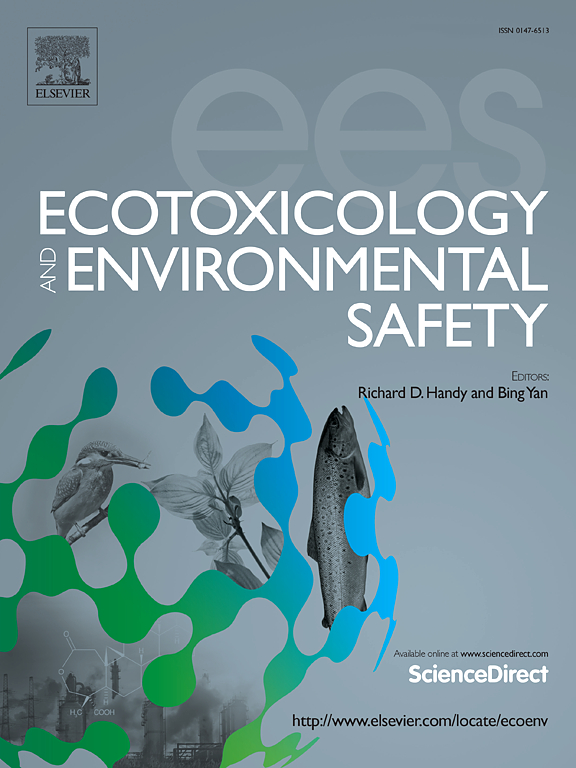Root acid phosphatases and microbial biomass phosphorus induced Cd tolerance and P acquisition in wheat inoculated with P solubilizing bacteria
IF 6.2
2区 环境科学与生态学
Q1 ENVIRONMENTAL SCIENCES
引用次数: 0
Abstract
Microbial bioremediation has emerged promisingly to improve crop tolerance to cadmium (Cd). Moreover, Cd tolerance and phosphate acquisition in plants positively correlated under P solubilizing bacteria inoculation, yet there is no evidence on specific mechanisms influencing Cd tolerance and plant P acquisition. The present study evaluates Cd tolerance in rock P-amended durum wheat in response to inoculation with P solubilizing bacteria (PSB) [three individual isolates Bacillus siamensis, Rahnella aceris, Bacillus cereus and their consortium (PSBCs)] and consequently reveals key rhizosphere mechanisms involved in both Cd tolerance and P use efficiency. Results show that inoculation overall improved plant growth, rhizosphere parameters and nutrient uptake (P, N, K) under increasing Cd concentrations [8 (Cd8) and 16 (Cd16) ppm Cd2+]. Under Cd16, Rahnella aceris induced the most significant plant responses in terms of biomass [shoots (31 %), roots (40 %), and spikes (92 %)], rhizosphere available P (234 %) and root inorganic P (109 %) compared to uninoculated plant. Microbial biomass P (MBP) and root acid phosphatases (APase) were 33-and 13-times higher, respectively, than in uninoculated plants. In addition, inoculation (particularly using PSBCs) significantly decreased Cd translocation factor (TF) (Cd8: −17 % and Cd16: −22 %) and Cd bioaccumulation factor (BAF) (Cd8: −6 % and Cd16: −40 %) concomitantly to enhanced root morphological traits and P contents in shoots and spikes. Furthermore, PSB inoculation under Cd constraint increased (rhizosphere available P / MBP) and (Root APase / Rhizosphere Apase) ratios that significantly (p < 0.05) correlate with plant P uptake in shoots and spikes. Increase in both ratios was concomitant to a significant decrease in TF and BAF of Cd exemplified by negatively significant correlations (r2=0.70 and r2=0.57, p < 0.05). This finding elucidates the key role of bacterial inoculation that presumably triggered Cd tolerance and aboveground P owing to increased (rhizosphere available P / MBP) and (Root / Rhizosphere APase) ratios in PSB-inoculated wheat.
根酸性磷酸酶和微生物量磷诱导施磷菌对小麦Cd的耐受性和磷的获取
微生物生物修复技术有望提高作物对镉的耐受性。此外,植磷增溶菌对植物Cd耐受性和磷获取的影响正相关,但影响植物Cd耐受性和磷获取的具体机制尚不清楚。本研究评估了磷溶化菌(PSB)对岩石磷改性硬粒小麦(rock - P-amended durum wheat)耐Cd性的影响,并由此揭示了影响耐Cd性和磷利用效率的关键根际机制。PSB是三种分离的siambacillus, acerrahnella, cereus及其联合体。结果表明,在Cd浓度[8 (Cd8)和16 (Cd16) ppm Cd2+]增加的情况下,接种总体上改善了植株生长、根际参数和养分吸收(P、N、K)。Cd16处理下,与未接种植株相比,在生物量[茎(31 %)、根(40 %)和穗(92 %)]、根际有效磷(234 %)和根无机磷(109 %)方面,针叶Rahnella aceris诱导植株的响应最为显著。微生物生物量P (MBP)和根酸性磷酸酶(APase)分别比未接种植株高33倍和13倍。此外,接种(特别是使用PSBCs)显著降低了Cd转运因子(TF) (Cd8:−17 %和Cd16:−22 %)和Cd生物积累因子(BAF) (Cd8:−6 %和Cd16:−40 %),同时提高了根形态性状和茎和穗状体中P含量。此外,在Cd约束下接种PSB可显著提高根际有效磷/ MBP和根际磷酸酶/根际磷酸酶比值(P <;0.05)与植物对磷素的吸收有关。这两个比值的增加都伴随着Cd的TF和BAF的显著下降,呈负显著相关(r2=0.70和r2=0.57, p <;0.05)。这一发现阐明了细菌接种的关键作用,可能是由于psb接种小麦根际有效磷/ MBP和根/根际磷酸酶比值的增加而引发Cd耐受性和地上磷。
本文章由计算机程序翻译,如有差异,请以英文原文为准。
求助全文
约1分钟内获得全文
求助全文
来源期刊
CiteScore
12.10
自引率
5.90%
发文量
1234
审稿时长
88 days
期刊介绍:
Ecotoxicology and Environmental Safety is a multi-disciplinary journal that focuses on understanding the exposure and effects of environmental contamination on organisms including human health. The scope of the journal covers three main themes. The topics within these themes, indicated below, include (but are not limited to) the following: Ecotoxicology、Environmental Chemistry、Environmental Safety etc.

 求助内容:
求助内容: 应助结果提醒方式:
应助结果提醒方式:


